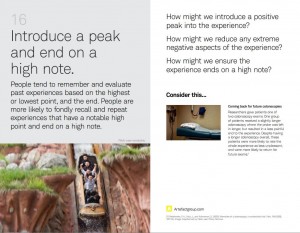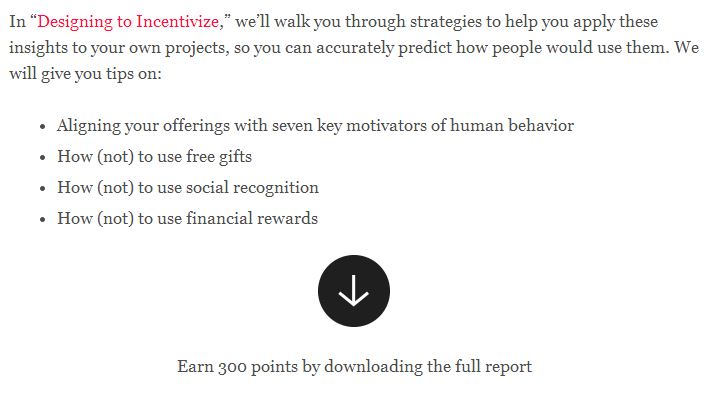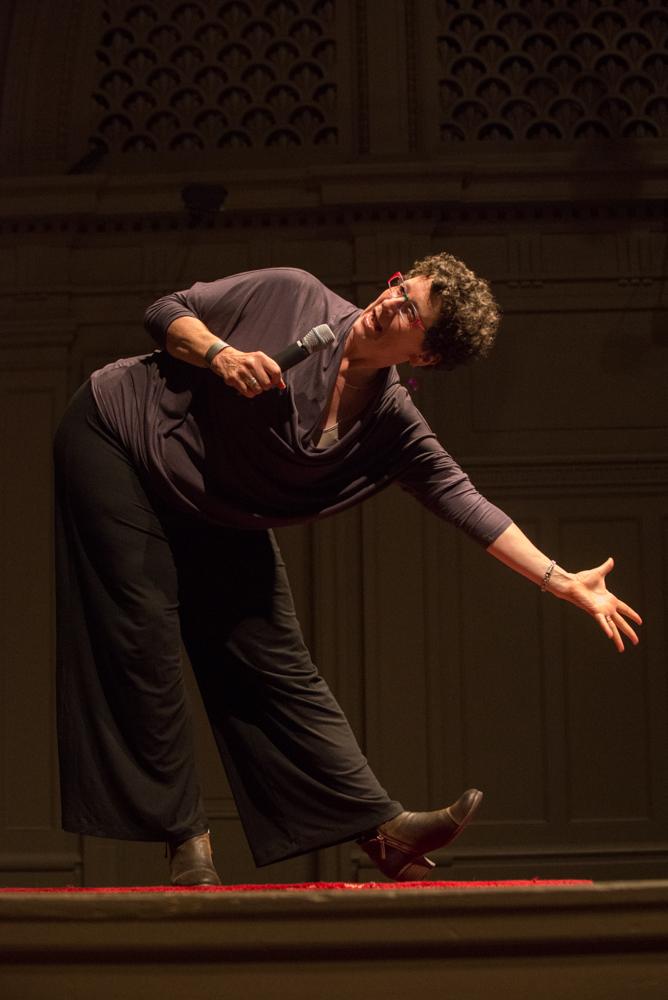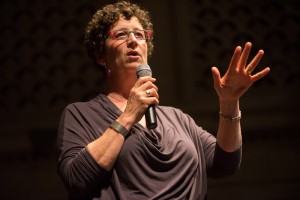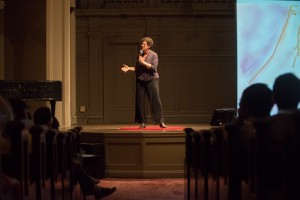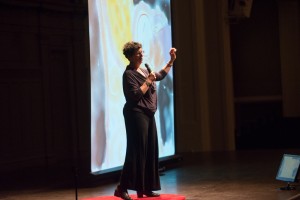This is the third in a series of posts about my ISS/Chisholm Fellowship in Victoria State, Australia. You can find the previous posts here: Part 1, Part 2.
 Both of my weeks in Victoria revolved around a series of workshops that were generally designed around the idea of increasing learner engagement. We played with all kinds of titles in advance, but of course, once I showed up and started to hear people’s stories, the new theme emerged: Relate and Liberate. I was very inspired by this quote:
Both of my weeks in Victoria revolved around a series of workshops that were generally designed around the idea of increasing learner engagement. We played with all kinds of titles in advance, but of course, once I showed up and started to hear people’s stories, the new theme emerged: Relate and Liberate. I was very inspired by this quote:
“If you have come here to help me, you are wasting your time. But if you have come because your liberation is bound up with mine, then let us work together.” Lilla Watson (Quote found via The Interaction Institute/ )
Coincidentally, an essay by Clay Shirky, The Digital Revolution Has Already Happened” was circulating when I was planning and it really hit home. In it Clay talks about the importance the access online learning has provided.
I also wanted to focus on relationship centric teaching using conversational approaches. This was supported by a graphic facilitation workshop, which in the end, applied the relationship centric approach while introducing the joy of visuals and graphic facilitation in teaching and learning. You can read more about that workshop in Part 4.
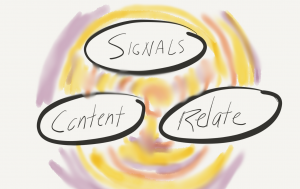 Finally, I wanted to try out some thinking that I’ve been doing around how to shift such a strong emphasis on content to a “three legged stool” approach that looks at the interplay between content, relationship and social scaffolding, and signals (quantitative and qualitative data that helps us make sense of what is happening) not just from our courses, but across courses and options made possible by open learning. That will have to wait for a full blog post, but I’ll slide in my sketch here and leave it at that for now.
Finally, I wanted to try out some thinking that I’ve been doing around how to shift such a strong emphasis on content to a “three legged stool” approach that looks at the interplay between content, relationship and social scaffolding, and signals (quantitative and qualitative data that helps us make sense of what is happening) not just from our courses, but across courses and options made possible by open learning. That will have to wait for a full blog post, but I’ll slide in my sketch here and leave it at that for now.
I was surprised that most of the participants were primarily teaching face to face. In my past visits to Australia to hang out with my educator friends, the emphasis had been much more strongly positioned on the online. So I made sure to talk about both online and offline contexts around the materials and processes. The first group at Chisholm were the Learning Leaders working on community based education. The introduction was strongly tilted towards seeing learning as liberation. I have a deep fondness for community based learning. The subsequent sessions were mostly TAFE educators or designers of learning courses and materials.
Process
In all of the workshops I tried to hold myself to the standard of walking my own talk. My plan was to focus on identity and relationship as a key to engaged teaching and learning, and use methods from Liberating Structures as a set of exemplar processes to embody this approach. That meant a focus on liberating the intelligence and passion in the room, making time for connections and creating conditions for useful conversations. My role was to be a catalyst, rather than positioning myself as the expert. This is a good thing, because I’m a learner first, expert… well, that is way down my “identity” list!
Liberating Structures were part of every workshop. We used Impromptu Networking to identify shared challenges, 1-2-4-All to make sense across those challenges. Then the subsequent structures varied by workshop. We very successfully used Troika Consulting (I keep calling it by the name I know – Triad Consulting!) and Discovery and Action Dialog (DAD) to help address the challenges each group identified, W3 to evaluate the session, tagging on 15% Solution as the “What Next” step of W3 to identify a simple follow up step. In some of the workshops we ended with a simple appreciative networking activity to note who contributed to our experience during the workshop, and who people wanted to follow up with.
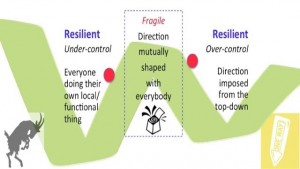 In each of the workshops I offered a quick overview of Liberating Structures (see slides) that covered the micro structure concept and some other example structures. But I have found it has been more useful to USE them, then as appropriate, debrief them, rather than “preach” them. I reviewed the basics of LS by showing a slide about the micro structures, the list of the 33 structures and shared Keith McCandless’ recent thinking about that (fragile) and rich space between over control and under control (goat rodeo – see Keith’s image to the right!) In the workshops there was insufficient time to talk about how to build an entire agenda by “stringing” structures, so I have included some examples at the end of the slide deck. That probably should have a blog post of it’s own!
In each of the workshops I offered a quick overview of Liberating Structures (see slides) that covered the micro structure concept and some other example structures. But I have found it has been more useful to USE them, then as appropriate, debrief them, rather than “preach” them. I reviewed the basics of LS by showing a slide about the micro structures, the list of the 33 structures and shared Keith McCandless’ recent thinking about that (fragile) and rich space between over control and under control (goat rodeo – see Keith’s image to the right!) In the workshops there was insufficient time to talk about how to build an entire agenda by “stringing” structures, so I have included some examples at the end of the slide deck. That probably should have a blog post of it’s own!
In the session where we did DAD, I really appreciate the reflections about the value of iteration in DaD, and in staying close to the questions that are at the core of the structure to avoid “goat rodeo.” Goat rodeo is everyone doing their own thing. Smart people fall into this trap all the time. In Troika, many people mentioned the freedom of turning one’s back to listen in. In all the structures people noted the deep importance of the starting questions. The more specific the question, the more precise answers are liberated.
A fabulous question was “when is it appropriate to use LS.” I offered an answer, but I also suggested I email everyone in a month and find out what they have used and done, and we’ll generate an “in situ” answer — nothing like reality!
Participant Feedback
In most of the workshops we did the “What, So What, Now What” debrief and reflect Liberating Structures. I was able to capture a few responses on video. Here is the result:
In addition, I received this quote in the mail this past week with permission to quote anonymously:
Hi Nancy,
Just a quick not to say thankyou for coming out to Australia, visiting us and giving us insight to your perspectives.
Can I just say that I thoroughly enjoyed it and put a couple of things into practice, nothing special but I went into class with a much more open mind and content within myself.
I ended up combining 2 groups from 2 campuses for the final 5 classes and although the first night’s turnout was a little lacking, by the end they were developing new workgroups, mixing on their own, helping each other in understanding assessments and to top it off they even arranged a Christmas breakup for both groups together.
The last night was purely a submitting work and as a help session for those that hadn’t finished or submitted all their work and I still had nearly a full class! They brought in cakes, all shook hands and celebrated and it was a genuinely nice thing to see. Especially when most stayed around until 8pm on a work night.
I wish you all the best in your travels and business.
Take care,
My Reflections
 Identity & Good Teaching
Identity & Good Teaching
This issue came up most strongly in the workshops hosted by eWorks the last day of my fellowship. I took this little visual note on the white board. Our conversation about educators having a strong self identity as educators was the basis of good teaching. Good teaching comes before any facility with online teaching. It always goes back to those basics. This is no surprise, but surprisingly this concept can get lost with online initiatives because people focus so intently on content. Content alone can be found many places. The unique offering of the TAFE institutions is GOOD TEACHING.
Conversational Teaching
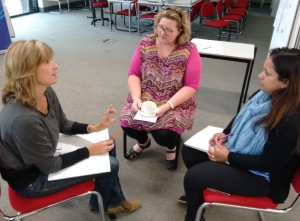 An essential practice of good teaching – online or offline – is getting immediately into good and useful conversations. I asked people at many of the workshops if they struggled with discussion boards and many raised their hands. I suggested that we need to think carefully and skillfully about how we engage people so that things like discussion forums and web meetings are meaningful, not just things learners have to to. NO TICK THE BOX! This is where we can always improve our skill at designing really engaging questions that people can’t resist responding to, versus canned “discussion prompts.”
An essential practice of good teaching – online or offline – is getting immediately into good and useful conversations. I asked people at many of the workshops if they struggled with discussion boards and many raised their hands. I suggested that we need to think carefully and skillfully about how we engage people so that things like discussion forums and web meetings are meaningful, not just things learners have to to. NO TICK THE BOX! This is where we can always improve our skill at designing really engaging questions that people can’t resist responding to, versus canned “discussion prompts.”
In our workshops, every session was started with a conversational approach that asked people what they wanted to get out of the session and what they had to offer. This activity helped me know what they wanted, and acknowledged their expertise as educators and designers of learning. The process used rotating paired conversation and without fail, the buzz in the room was robust and it was always hard to get people to stop talking. I take that as a sign of engagement! (Yes, they could have been complaining about me or the process… 😉 ) But again, this acknowledges identity in the context of meaningful conversation.
I asked people how they currently open conversations in their teaching, and how they might change this. One person said he was going to take is face to face group to coffee, instead of starting by reviewing the syllabus. Another was going to use the paired drawing exercise we did in the graphic facilitation workshop to help learners create relationships right from the start. Just two examples!
It was interesting to be in rooms with so many smart and passionate people, yet I sensed a reluctance for people to speak up at the full group level. Is this part of the identity thing? IS there a “tall poppy syndrome” issue in these organizations? It may be some of those things, but for me it was yet another example of the critical importance of breaking people into smaller groups because intense, buzzing, engaged conversation emerged every time at the small group level.
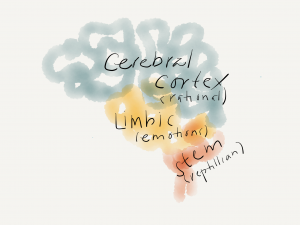 Brain Based Approaches
Brain Based Approaches
Before the workshops I happened on a fascinating article on neurobiology. It described how neurobiology might inform our teaching practices, particularly the work of Dan Siegel. He talks about the unity of the “triume brain” of cerebral cortex (rational brain), the limbic system (emotional brain) and the stem (reptilian brain). Siegel “envisions the brain as a social organ,” and “the emotional system that develops in relationship.” I was taken how he describes a “sixth sense” as “mindsight,” and links this to mirror neurons. “What fires together, wires together,” is a way he talks about how we learn by what we observe. If we observer our teachers functioning as learners, will we be better learners? I think so… Siegel talks about the power of associations that people make in order to make sense of the world. Positive and uplifting associations can be more meaningful, encouraging, and benefit change. There was so much in this and I only scratched the surface. But by the second week I had to make a visual…
Remember Group Process
A post on Facebook by the fabulous Chris Corrigan reminded me of some very resonant practices from the Art of Hosting and I gr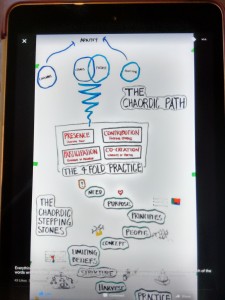 abbed an image to share about the Four-Fold path of Presence, Contribution, Participation and Co-Creation. I am a little shocked when I don’t see many of the deep process work from the facilitation community in teaching and learning. There are natural connections. So introducing across these communities is a particular joy. Going by to my “three legged stool” — this is the relational aspect. How we interact is as important as what we are interacting about.
abbed an image to share about the Four-Fold path of Presence, Contribution, Participation and Co-Creation. I am a little shocked when I don’t see many of the deep process work from the facilitation community in teaching and learning. There are natural connections. So introducing across these communities is a particular joy. Going by to my “three legged stool” — this is the relational aspect. How we interact is as important as what we are interacting about.
Share Real Examples
Finally, it was fabulous to hear the examples of the educators in each workshop. In turn, I was able to share about a project I’m working on with an international team sponsored by the Justice Institute of British Columbia and the University of Guadalajara, the UdG Agora Project. You can take a peek at a recent presentation online about the project from #OpenEd15.
Slides & Resources
- Relate and Liberate – Compiled slides, notes and additional materials.
- Full Circle Associates http://fullcirc.com/wp
- Liberating Structures http://www.liberatingstructures.com
- The Art of Hosting http://www.artofhosting.org/ and https://www.youtube.com/watch?v=FWodPL9C1UI
- Clay Shirky “The Digital Revolution Has Already Happened” https://medium.com/@cshirky/the-digital-revolution-in-higher-education-has-already-happened-no-one-noticed-78ec0fec16c7
- UdG Agora Project http://udg.theagoraonline.net/ and a presentation online about the project from OpenEd15 http://udg.theagoraonline.net/opened15/
- Wenger- Trayner et. al. Value Creation Framework – http://wenger-trayner.com/tag/value-creation/



